SUBCONTINENT:
Energy and Expediency: India's Myanmar Ties
Although the current Myanmar military junta’s human rights record has drawn widespread global scorn, energy hungry India and China, apart from Thailand, South Korea and Russia, have found the riches of Myanmar difficult to resist, writes Siddharth Srivastava.
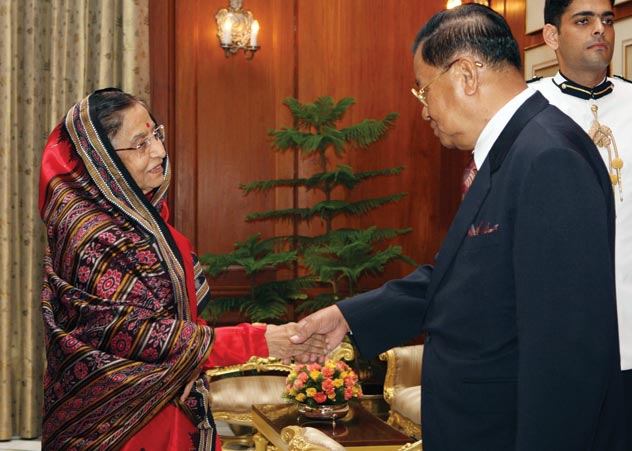
(Above): Myanmar State Peace and Development Council chairman Sr. Gen. Than Shwe called on Indian President Pratibha Devisingh Patil at Rashtrapati Bhavan in New Delhi July 27. Despite sharp criticism of the present Myanmar regime’s anti-democracy record, India, like several other countries, has allowed economic expediency to trump human rights concerns as it eyes Myanmar’s huge oil and gas reserves. [Photo: PRESS INFORMATION BUREAU]
The military junta recently released pro-democracy icon Aung San Suu Kyi. But it will be a while before the entrenched rulers of Myanmar can be removed from power.
Meanwhile, despite Western misgivings foreign interest in Myanmar’s oil and gas sector grows. Many energy firms, it seems, will not hold investments till political change happens.
Though American and European firms have kept away from Myanmar, energy hungry India and China, apart from Thailand, South Korea and Russia, have found the riches of Myanmar difficult to resist.
These countries have sided with Myanmar in international forums with some purpose. Despite calls for sanctions against Yangon for its alleged human rights violations, nearly 30 firms from 13 countries have invested in Myanmar’s hydrocarbon sector.
At least seven foreign firms are officially recorded as operating onshore in Myanmar – Indian Essar Oil, Focus Energy, MPRL (a subsidiary of explorer ONGC), Goldpetrol, the Chinese CNOOC, Sinopec Oil Company and Chinerry Assets.
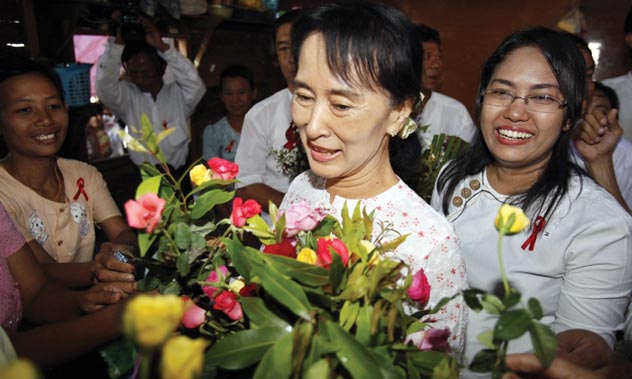
(Above): Myanmar’s democracy activist and Nobel Peace Prize-winner Aung San Suu Kyi. Her struggle to bring democracy to Myanmar has wide worldwide support.
Myanmar is home to around 47 inland crude oil and natural gas fields with 12 more being extended, apart from offshore gas areas. Experts believe that there are still large unexplored areas in Myanmar. Myanmar has proven gas reserves of 19 trillion cubic feet.
Gas reserves of around 6.0 tcf have been estimated in the blocks off Burma’s Arakan coast. Yangon claims that Myanmar possesses 90 tcf of gas and 3.2 billion barrels of recoverable crude oil reserves, though independent estimates are much less.
Yangon has been moving quickly to set up the requisite infrastructure to tap its big hydrocarbon sources to earn export and transit revenues and plug internal shortages of fuel and power.
Yangon is expected to earn $1billion every year from the pipelines over the next 30 years.
In this context, the local Weekly Eleven News reported this month that Myanmar and Russian oil companies will together explore crude oil and natural gas in Shwe U-ru block (B-2) in Homelin town ship in Sagaing region,
The project will be implemented by Myanmar’s private Htoo Group companies and the closed joint stock oil company Noble Oil of the Russian Federation.
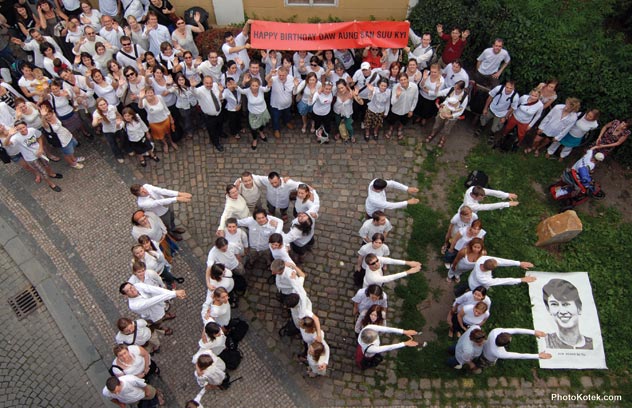
(Above): Czech supporters demonstrate in support of Myanmar democracy activist Aung San Suu Kyi.
Since 2006, three Russian oil companies have been involved exploration in Myanmar — JSC Zarubezhneft Iteraaws, Silver Wave Sputnik Petroleum and Silver Wave Energy.
In the recent past, India’s upstream oil majors Oil India, Gas Authority of India and Oil & Natural Gas Corp have renewed efforts to seek new opportunities in gas-rich Myanmar.
“We are looking at acquiring stakes in Myanmar,” N.M. Borah, chairman and managing director of Oil India, said recently. “We will be forming partnerships with ONGC and GAIL that already have interests in the country. The modalities will be finalized very soon,’’ he added.
Earlier this year, ONGC and GAIL were given permission by New Delhi to pick up a stake in the gas pipeline that China is building for transporting natural gas off the Myanmar coast to the southwest Yunnan province.
Both ONGC Videsh, the foreign arm of the state explorer and GAIL will together be putting over $251 million in the pipeline, even as the two companies have plans to invest nearly $2 billion in Myanmar.
Myanmar has also initiated discussions with Bangladesh and India on the 950 km, $1 billion Myanmar-Bangladesh-India tri-nation gas pipeline, as Dhaka is now inclined to see the project through, given its improved relations with New Delhi.
Having lost out on the $7.5 billion Iran-Pakistan-India pipeline due to geo-political and security reasons, India is keen to procure gas from Myanmar.
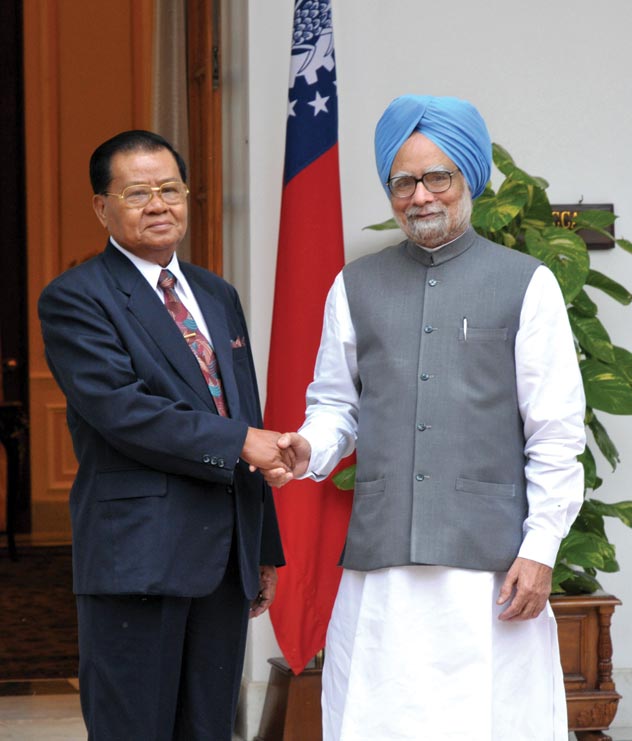
(Above): Indian Prime Minister Manmohan Singh (r) meeting Myanmar State Peace and Development Council chairman Sr. Gen. Than Shwe in New Delhi July 27. [Photo: PRESS INFORMATION BUREAU]
Indeed, the competition for Myanmar energy sources is stiff. India’s oil ministry has proposed a sovereign fund of $20 billion to enable state firms acquire energy assets abroad. This amount is, however, puny compared to China’s energy war chest estimated at $300 billion.
Beijing has been pushing for a network of oil and gas pipelines from Myanmar to tap the country’s resources. These frameworks will also allow China much-needed access to an Indian Ocean oil port in Myanmar that will connect to oil hubs in the Middle East and Africa.
Despite bagging energy blocks in Myanmar, Indian firms have not succeeded in transporting the gas to India due to absence of a pipeline. Yangon has instead signed the sale contracts with China.
China National Petroleum Corp is laying the pipeline in Myanmar to transport in blocks A-1 and A-3 to mainland China and has offered a 49.9 percent stake to the consortium developing the gas fields.
The consortium comprising South Korea’s Daewoo Corp (51 percent), OVL (17 percent), GAIL (8.5 percent), KOGAS (Korea Gas Corp, 8.5 percent) and MOGE (Myanmar’s Myanmar Oil and Gas Enterprise, 15 percent), intends to invest nearly $4 billion in bringing to production gas fields in the two blocks.
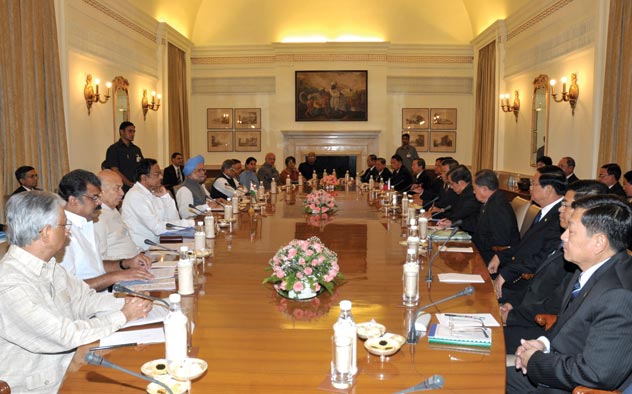
(Above): Indian Prime Minister Manmohan Singh at delegation level talks with Myanmar State Peace and Development Council chairman Sr. Gen. Than Shwe in New Delhi on July 27. PRESS INFORMATION BUREAU. [Photo: PRESS INFORMATION BUREAU]
The Korean Gas Corp and Daewoo International together already hold a major stake in the Shwe fields with total reserves certified between 4.5 tcf and 7.75 tcf.
Earlier this year, South Korea announced plans to collaborate with Myanmar to jointly exploit two gas blocks. The pact was hailed as a “new era in our (Korea’s) history of energy diplomacy with Myanmar, a resource-rich country trying to change into a free democracy.” Given Myanmar’s political circumstances, the statement is positively Orwellian.
Meanwhile, China and India are also looking to considerably deepen their presence in Myanmar’s hydro sector, with Indian state-owned National Hydro Power Company Limited earmarking over $ 5.6 billion investments in the Myanmar energy sector.
|